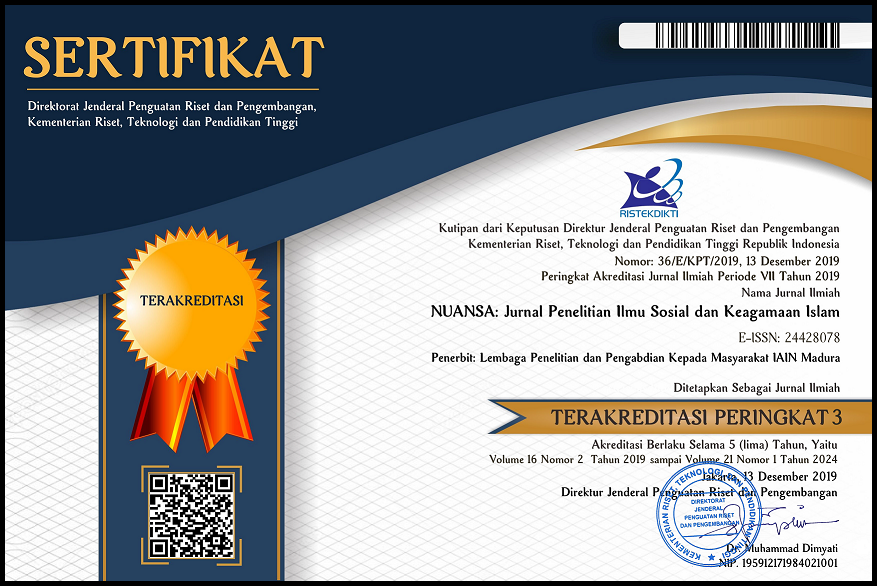Muslim Students Consciousness to Use Halal Cosmetic Products at Semarang City, a psychological analysis
 Abstract views: 219
,
Abstract views: 219
,
 PDF downloads: 166
PDF downloads: 166
Abstract
It is important to know the awareness of Muslimah students using halal cosmetics to protect Muslim consumers in the use of cosmetic products. This study aims to describe how consciousness of Muslim students at Semarang to use halal cosmetics. Researchers used mix-method qualitative-quantitative research methods with survey techniques. Sampling was done by using cluster random sampling technique at public and religious universities in Semarang City. Data collection techniques used questionnaire on 145 female students from 7 major universities in the city of Semarang. Last analysis used religious psychology. The results of the research have shown that their level of consciousness to carry out Islamic values in daily life reaches 90.3%. The relationship between religious consciousness and the use of halal products among Muslim female students from both santri and non-santri in Semarang City is very high (71%) Thus, that attitude of students is included in self-directive religious consciousness category, namely religious behavior due to personal encouragement, and not affected by the environment.
Downloads
References
Bastaman, Hanna Djumhana. Integrasi Psikologi Dengan Islam. Yogyakarta: Pustaka Pelajar, 1997.
BPS, Kota Semarang. Kota Semarang Dalam Angka Semarang Municipality in Figures 2 0 2 1. Semarang: BPS Kota Semarang, 2021.
“Cek Produk BPOM - BPOM RI.” Accessed July 17, 2019. https://cekbpom.pom.go.id/index.php/home/produk/fjrik9jd2kkukf9vphreoj4es7/top2019/12/row/10/page/2/order/4/DESC.
Data questionnaire. “Data Survei, October 2021.” Semarang City, 2021.
Geertz, Clifford. The Religion of Java. Chicago: University of Chicago Press, 1976.
Hasanah, Hasyim. “Peran Strategis Aktifis Perempuan Nurul Jannah Al Firdaus Dalam Membentuk Kesadaran Beragama Perempuan Miskin Kota.” INFERENSI: Jurnal Penelitian Sosial Keagamaan 7, no. 2 (December 1, 2013): 473–92. https://doi.org/10.18326/INFSL3.V7I2.473-492.
Pratt, James Bisset. The Religious Consciousness. New York: Casimo, Inc, 2015.
Ramayulis. Psikoogi Agama. Jakarta: Kalam Mulia, 2002.
Saifuddin, Ahmad. Psikologi Agama: Implementasi Psikologi Untuk Memahami Perilaku Agama. Jakarta: Kencana, 2019.
Segal, Robert A. “Weber and Geertz on the Meaning of Religion.” Religion 29, no. 1 (1999): 61–71. https://doi.org/10.1006/reli.1998.0178.
Sinelina, Iu. Iu. “Dynamics of Religiosity Among Russians and Some Methodological Problems of Its Study.” Sociological Research 53, no. 5 (2014): 61–80. https://doi.org/10.2753/sor1061-0154530505.
Watson, Arthur Clinton. The Logic of Religion. Chicago: The University of Chicago Libraries, 1918.
Weber, Max. The Sociology of Religion. United States: Beacon Press, 1993.
Wettstein, Howard. The Significance of Religious Experience. New York: Oxford University Press, 2012.
Zakiyah Daradjat. Psikologi Agama. Jakarta: Bulan Bintang, 1979.
Copyright (c) 2024 NUANSA: Jurnal Penelitian Ilmu Sosial dan Keagamaan Islam

This work is licensed under a Creative Commons Attribution-NonCommercial 4.0 International License.
The journal operates an Open Access policy under a Creative Commons Attribution-NonCommercial 4.0 International License (CC-BY-NC) 
Authors who publish with this journal agree to the following terms:
- Authors retain copyright and grant the journal right of first publication with the work simultaneously licensed under a Creative Commons Attribution License that allows others to share the work with an acknowledgement of the work's authorship and initial publication in this journal.
- Authors are able to enter into separate, additional contractual arrangements for the non-exclusive distribution of the journal's published version of the work (e.g., post it to an institutional repository or publish it in a book), with an acknowledgement of its initial publication in this journal.
- Authors are permitted and encouraged to post their work online (e.g., in institutional repositories or on their website) prior to and during the submission process, as it can lead to productive exchanges, as well as earlier and greater citation of published work.





















